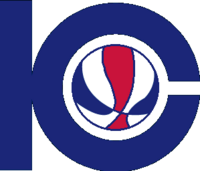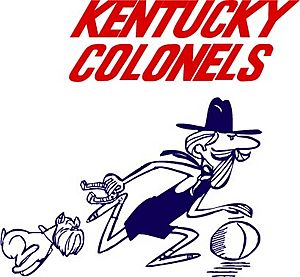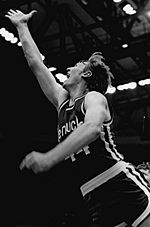Kentucky Colonels facts for kids
Quick facts for kids Kentucky Colonels |
|
|---|---|
 |
|
| Conference | None |
| Division | Eastern Division |
| Founded | 1967 |
| Folded | 1976 |
| History | Kentucky Colonels 1967–1976 |
| Arena | Louisville Convention Center (1967–1970) Freedom Hall (1970–1976) |
| Location | Louisville, Kentucky |
| Team colors | Chartreuse and white (1967–1970) Blue, red, and white (1970–1976) |
| Head coach | (1967) John Givens (1967–1970) Gene Rhodes (1970) Alex Groza (1970–1971) Frank Ramsey (1971–1973) Joe Mullaney (1973–1974) Babe McCarthy (1974–1976) Hubie Brown |
| Ownership | Don Regan (1967) Joseph E. Gregory, Mamie Gregory, and William C. Boone (1967–1969) H. Wendell Cherry, Bill DeWitt, Stuart Jay, David Jones, John Y. Brown, Jr., and Mike Storen (1969–1973) John Y. Brown, Jr. and Ellie Brown (1973–1976) |
| Championships | 1 (1975) |
| Division titles | 2 (1972, 1975) |
The Kentucky Colonels were a professional basketball team. They were part of the American Basketball Association (ABA) for all nine years it existed. The team's name came from the historic Kentucky colonels. The Colonels won more games and had a better winning record than any other team in the league's history. However, they did not join the NBA when the ABA and NBA merged in 1976.
The Colonels first played their home games at the Louisville Convention Center in downtown Louisville. After three seasons, they moved to Freedom Hall for their remaining years, starting in 1970. The Kentucky Colonels were one of only two ABA teams, along with the Indiana Pacers, that stayed in the same city and kept the same name for the entire time the league was around.
Contents
About the Team
The Kentucky Colonels, based in Louisville, were known for being a lively team. This was partly because of their bright chartreuse green uniforms. They even had a special "mascot" named Ziggy, who was a prize-winning Brussels Griffon dog. Ziggy was owned by the team's first owners, Joe and Mamie Gregory.
The team was also famous for its fun publicity stunts. One of the most well-known stunts happened in 1968. Penny Ann Early, the first licensed female horse racing jockey, was signed to appear in an ABA game. She only played for a few seconds, but it was a big deal!
The team's look changed during the 1970–71 season. They signed another star player, Dan Issel, from the University of Kentucky. They also changed their bright green uniforms to blue and white, similar to the University of Kentucky's colors. Issel's arrival helped the Colonels become a serious basketball team. Even though their regular season record was just average, they almost won the 1971 ABA championship. They lost in a close seven-game series to the Utah Stars.
The Colonels became even stronger in 1971 when they signed Artis Gilmore. Gilmore's signing helped the team become a true powerhouse for many years. In his first year, the Colonels won 68 games under coach Joe Mullaney. This was the best record in the entire history of the ABA league! But in the playoffs, they were surprisingly defeated by the New York Nets in the first round. Kentucky tried again for a championship in the 1972–73 playoffs. They lost a tough series to the Indiana Pacers in seven games.
After that season, the team almost moved to Cincinnati. But then, John Y. Brown, Jr. bought the team. He later became the governor of Kentucky and used to own Kentucky Fried Chicken. Brown helped make the team more popular. He also wanted to improve their play, so he hired a famous ABA coach, Babe McCarthy. However, after the team was swept in the playoffs by the Nets, McCarthy was fired.
For the 1974–75 season, Brown hired Hubie Brown (no relation to John Y. Brown). Hubie was a former NBA assistant coach. He helped the Colonels finally win their championship! After a great end to the regular season, where they won 23 out of 26 games, they dominated the playoffs. They beat their rivals, the Indiana Pacers, in a strong 4-1 victory to win the 1975 ABA championship. In the final game, Gilmore scored 28 points and grabbed an amazing 31 rebounds.
That same year, the Golden State Warriors won the NBA Title. Colonels owner John Y. Brown offered the NBA Champions a million dollars to play a single game to decide the "world championship." The Warriors and the NBA refused.
The celebration of the 1975 season ended when John Y. Brown, Jr. traded Dan Issel to the new Baltimore Claws team. This was done for money reasons. The Claws team ended up folding after just a few preseason games and never played in the regular season. The Colonels got Caldwell Jones to replace Issel, but he didn't fit well with the team. Jones was traded mid-season for a younger player, Maurice Lucas. Coach Hubie Brown kept the team competitive, but they lost in the playoffs to the Denver Nuggets in seven games.
The Kentucky Colonels were one of the strongest teams in the ABA, both on the court and with their fans. They had many talented players and a great fan base. However, when the ABA and NBA talked about merging, the Chicago Bulls from the NBA did not want the Colonels to join. The Bulls had the NBA rights to Artis Gilmore and really wanted him on their team. Because of this, John Y. Brown, Jr. had to close down the Colonels. Brown did get an NBA team later. He bought the Buffalo Braves in 1976, and then traded that team for the famous Boston Celtics two years later.
After the Colonels closed, their players were chosen by other teams in a special draft. Artis Gilmore went to the Chicago Bulls. Maurice Lucas became an all-star for the Portland Trail Blazers. Louie Dampier, who was the Colonels' all-time leader in points and assists, finished his career with the San Antonio Spurs. Coach Hubie Brown went on to coach the Atlanta Hawks in the NBA.
The Colonels won 448 games in the ABA, which was more than any other team. Their overall regular season record was 448 wins and 296 losses. Their winning percentage of .602 was better than almost every other ABA team. In the playoffs, the Colonels won 55 games and lost 46. Only the Indiana Pacers won more ABA playoff games.
Season Highlights
The Kentucky Colonels had many exciting seasons during their time in the ABA. Here are some of the key moments from each year:
1967–1968 Season
The Kentucky Colonels team was started on March 6, 1967. Don Regan paid $30,000 for the team. Later, Joseph and Mamie Gregory and William C. Boone bought the team. John Givens was the first coach. Key players like Louie Dampier and Randy Mahaffey joined the team. The Colonels played their home games at the Louisville Convention Center and Freedom Hall. After a slow start, Gene Rhodes became the coach. The team finished with 36 wins and 42 losses. They made it to the Eastern Division semifinals but lost to the Minnesota Muskies.
1968–1969 Season
The Colonels hosted the 1969 ABA All-Star Game in Louisville. Coach Gene Rhodes led the East team. Players like Darel Carrier, Louie Dampier, and Jim "Goose" Ligon were All-Stars. This season was also famous for Penny Ann Early, the jockey, briefly appearing in a game. The Colonels finished third in their division with a 42–36 record. They lost a close playoff series to the Indiana Pacers.
1969–1970 Season
In April 1969, a new group of investors from Louisville bought the Colonels. This group included John Y. Brown, Jr.. Darel Carrier, Louie Dampier, and Gene Moore were chosen for the ABA All-Star Game. The team finished second in the Eastern Division with a 45–39 record. They won their first playoff series against the New York Nets but then lost to the Indiana Pacers in the Eastern Division finals.
1970–1971 Season
The Colonels signed University of Kentucky star Dan Issel to a big contract. They also moved their home games to Freedom Hall. Coach Gene Rhodes was fired and replaced by Frank Ramsey. Dan Issel and Cincy Powell played in the ABA All-Star Game. Issel was named Co-Rookie of the Year. The Colonels finished second in their division. They made a strong run in the playoffs, winning two series. They reached the ABA Championship but lost a very close Game 7 to the Utah Stars.
1971–1972 Season
The Colonels drafted Artis Gilmore, who signed a large contract. Joe Mullaney became the new coach. The Colonels played exhibition games against NBA teams, even beating the Baltimore Bullets. Dan Issel, Louie Dampier, and Artis Gilmore were all chosen for the ABA All-Star Game. Gilmore was named the league's Most Valuable Player and Rookie of the Year. Kentucky had an amazing regular season, winning 68 games and losing only 16. This was the best record in ABA history! However, their great season ended surprisingly when they lost in the first round of the playoffs to the New York Nets.
1972–1973 Season
Louie Dampier, Dan Issel, and Artis Gilmore again played in the ABA All-Star Game. Gilmore was once again a First Team All-ABA player. The Colonels finished second in their division with 56 wins and 28 losses. They won two playoff series, beating the Virginia Squires and the Carolina Cougars. They then played in the ABA Championship against the Indiana Pacers but lost a very close series in seven games.
1973–1974 Season
John Y. Brown, Jr. and his wife Ellie Brown bought the team. Ellie Brown became the Chairman of the Board, which was made up of ten women. Legendary coach Adolph Rupp became Vice President. Babe McCarthy became the new head coach. Louie Dampier, Dan Issel, and Artis Gilmore were All-Stars again. Gilmore was named the All-Star Game's Most Valuable Player. The Colonels finished second in their division with 53 wins and 31 losses. They swept the Carolina Cougars in the first round of the playoffs but then lost to the New York Nets in the Eastern Division finals. Even though Babe McCarthy was named ABA Coach of the Year, he was fired.
1974–1975 Season
Hubie Brown was named the new head coach. Louie Dampier, Dan Issel, and Artis Gilmore were All-Stars. Gilmore was again a First Team All-ABA player. The Colonels finished first in the Eastern Division with 58 wins and 26 losses. They won a special game against the New York Nets to decide first place. Then, they swept through the playoffs, beating the Memphis Sounds and the Spirits of St. Louis. In the ABA Championship, they faced their rivals, the Indiana Pacers, and won the series 4-1 to claim their first ABA Championship! After winning, owner John Y. Brown offered $1 million to the NBA Champion Golden State Warriors to play a "world title" game, but the NBA refused.
1975–1976 Season
Before the season, the Colonels and the ABA challenged the NBA to a championship series between their champions, but the NBA declined. To the disappointment of fans, owner John Y. Brown, Jr. traded star player Dan Issel for money. Issel ended up with the Denver Nuggets. Artis Gilmore was an ABA All-Star and First Team All-ABA again. The Colonels finished fourth in their division with 46 wins and 38 losses. They beat the Indiana Pacers in the first round of the playoffs. In the semifinals, they played a tough seven-game series against the Denver Nuggets, but lost Game 7, which was their final game ever.
After the Colonels
The ABA had financial problems, and several teams folded during the 1975–76 season. When the ABA and NBA discussed merging, the NBA's Chicago Bulls did not want the Colonels to join. This was because the Bulls wanted to get Artis Gilmore in a special draft. In the end, the Colonels were not one of the four ABA teams that joined the NBA.
On July 17, 1976, the Kentucky Colonels team officially closed down. Owner John Y. Brown, Jr. received $3 million for folding the team. He used this money to buy the Buffalo Braves in the NBA. The Colonels' players were then chosen by other teams in a dispersal draft. The Chicago Bulls paid $1.1 million for Artis Gilmore. Maurice Lucas went to the Portland Trail Blazers, and Louie Dampier went to the San Antonio Spurs.
Basketball Hall of Famers
Several players and coaches from the Kentucky Colonels have been honored in the Basketball Hall of Fame.
| Kentucky Colonels Hall of Famers | ||||
|---|---|---|---|---|
| Players | ||||
| No. | Name | Position | Tenure | Inducted |
| 44 | Dan Issel | C/F | 1970–1975 | 1993 |
| 53 | Artis Gilmore | C | 1971–1976 | 2011 |
| 10 | Louie Dampier | G | 1967–1976 | 2015 |
| Coaches | ||||
| Frank Ramsey 1 | Head coach | 1970–1971 | 1982 | |
| Hubie Brown 2 | Head coach | 1974–1976 | 2005 | |
Notes:
- 1 Inducted as a player. Never played for the team.
- 2 Inducted as a contributor.
Season-by-season Records
Note: W = wins, L = losses, % = win–loss %
| Season | W | L | % | Playoffs | Results |
|---|---|---|---|---|---|
| Kentucky Colonels | |||||
| 1967–68 | 36 | 42 | .462 | Won 1968 Eastern Division Playoff Lost 1968 Eastern Division Semifinals |
Kentucky Colonels 1, New Jersey Americans 0 Minnesota Muskies 3, Kentucky Colonels 2 |
| 1968–69 | 42 | 36 | .538 | Lost 1969 Eastern Division Semifinals | Indiana Pacers 4, Kentucky Colonels 3 |
| 1969–70 | 45 | 39 | .536 | Won 1970 Eastern Division Semifinals Lost 1970 Eastern Division Finals |
Kentucky Colonels 4, New York Nets 3 Indiana Pacers 4, Kentucky Colonels 1 |
| 1970–71 | 44 | 40 | .524 | Won 1971 Eastern Division Semifinals Won 1971 Eastern Division Finals Lost 1971 ABA Finals |
Kentucky Colonels 4, The Floridans 2 Kentucky Colonels 4, Virginia Squires 2 Utah Stars 4, Kentucky Colonels 3 |
| 1971–72 | 68 | 16 | .810 | Lost 1972 Eastern Division Semifinals | New York Nets 4, Kentucky Colonels 2 |
| 1972–73 | 56 | 28 | .667 | Won 1973 Eastern Division Semifinals Won 1973 Eastern Division Finals Lost 1973 ABA Finals |
Kentucky Colonels 4, Virginia Squires 1 Kentucky Colonels 4, Carolina Cougars 3 Indiana Pacers 4, Kentucky Colonels 3 |
| 1973–74 | 53 | 31 | .631 | Won 1974 Eastern Division Semifinals Lost 1974 Eastern Division Finals |
Kentucky Colonels 4, Carolina Cougars 0 New York Nets 4, Kentucky Colonels 0 |
| 1974–75 | 58 | 26 | .690 | Won 1975 Eastern Division First Place Game Won 1975 Eastern Division Semifinals Won 1975 Eastern Division Finals Won 1975 ABA Finals |
Kentucky Colonels 1, New York Nets 0 Kentucky Colonels 4, Memphis Sounds 1 Kentucky Colonels 4, Spirits of St. Louis 1 Kentucky Colonels 4, Indiana Pacers 1 |
| 1975–76 | 46 | 38 | .548 | Won 1976 First Round Lost 1976 ABA Semifinals |
Kentucky Colonels 2, Indiana Pacers 1 Denver Nuggets 4, Kentucky Colonels 3 |
Broadcasts
Colonels games were broadcast on WHAS Radio. This was Louisville's most popular radio station at the time. It was a powerful station, so Colonels games could be heard across much of the United States at night! Van Vance was the main play-by-play announcer for most of the team's history. Cawood Ledford, who was famous for calling University of Kentucky Wildcats games, also worked on the broadcasts.
Some Colonels games were shown on local TV stations. However, they were mostly seen on TV during special ABA network games.
New Kentucky Colonels Team
In 2004, a new basketball league called the ABA 2000 brought a team to Louisville with the same name: the Kentucky Colonels.
See also
 In Spanish: Kentucky Colonels para niños
In Spanish: Kentucky Colonels para niños
- Kentucky Colonels (ABA 2000)
- Sports in Louisville, Kentucky
- 1968 ABA Playoffs
- 1969 ABA Playoffs
- 1970 ABA Playoffs
- 1971 ABA Playoffs
- 1972 ABA Playoffs
- 1973 ABA Playoffs
- 1974 ABA Playoffs
- 1975 ABA Playoffs
- 1976 ABA Playoffs
- 1973–74 Kentucky Colonels season
- 1974–75 Kentucky Colonels season



